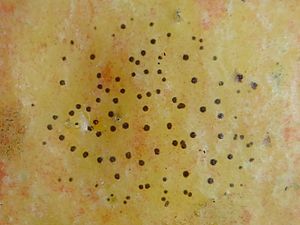Schizothyrium pomi facts for kids
Schizothyrium pomi is a tiny fungus that can make certain plants sick. It's part of a group of plant problems known as the sooty blotch and flyspeck complex. This fungus mainly affects fruits like apples, pears, and citrus. It can also cause problems for flowers like carnations. When Schizothyrium pomi infects a plant, it doesn't usually harm the inside of the fruit. Instead, it makes the outside look dirty or spotted.
Quick facts for kids Schizothyrium pomi |
|
|---|---|
 |
|
| Scientific classification | |
| Kingdom: | |
| Phylum: | |
| Class: |
Dothideomycetes
|
| Subclass: |
Dothideomycetidae
|
| Order: |
Microthyriales
|
| Family: |
Schizothyriaceae
|
| Genus: |
Schizothyrium
|
| Species: |
S. pomi
|
| Binomial name | |
| Schizothyrium pomi (Mont. & Fr.) Arx, (1959)
|
|
| Synonyms | |
|
Botryodiplodia pomi |
|
Contents
What is Schizothyrium Pomi?
Schizothyrium pomi is a type of fungus. Fungi are living things that are not plants or animals. Some fungi, like Schizothyrium pomi, are called plant pathogens. This means they can cause diseases in plants. They get their food from the plants they infect.
How Does It Affect Plants?
This fungus causes two main types of symptoms on fruit: sooty blotch and flyspeck. These names describe what the fruit looks like. The fungus grows on the surface of the fruit. It does not usually rot the fruit or make it unsafe to eat.
Sooty Blotch
Sooty blotch makes the fruit look like it's covered in soot or dirt. It appears as dark, smudgy patches. These patches can be olive green or black. They often spread out over a large area of the fruit's skin.
Flyspeck
Flyspeck looks like tiny, shiny black dots on the fruit. These dots are usually round and raised. They often appear in small clusters. They look a lot like tiny specks of fly dirt, which is how they got their name.
Which Plants Are Affected?
Schizothyrium pomi can infect several important fruit trees. It is well-known for causing problems in apple and pear orchards. It also affects citrus fruits like oranges and lemons. Beyond fruit trees, it can also infect ornamental plants such as carnations.
Apple Trees
Apples are a common target for this fungus. The sooty blotch and flyspeck can make apples look less appealing. This can make them harder to sell in stores.
Pear Trees
Pears can also show signs of sooty blotch and flyspeck. The fungus grows on the pear's skin. It creates similar dark smudges and tiny black dots.
Citrus Trees
Citrus fruits, like oranges and grapefruits, can also be affected. The fungus grows on their peels. This makes the fruit look dirty, even though the inside is usually fine.
Carnations
Carnations are popular flowers. Schizothyrium pomi can cause spots on their leaves or stems. This can make the flowers look unhealthy.
How Does It Spread?
The fungus spreads through tiny spores. These spores are like tiny seeds. They can be carried by wind or splashed by rain. They land on the surface of plants. If conditions are right, the spores will grow and cause an infection. The fungus prefers warm, humid weather.
Protecting Plants from Schizothyrium Pomi
Farmers and gardeners use different methods to protect their plants. One way is to prune trees. Pruning helps air move through the branches. This makes the area less humid. Keeping weeds down also helps. Sometimes, special sprays are used to prevent the fungus from growing.

